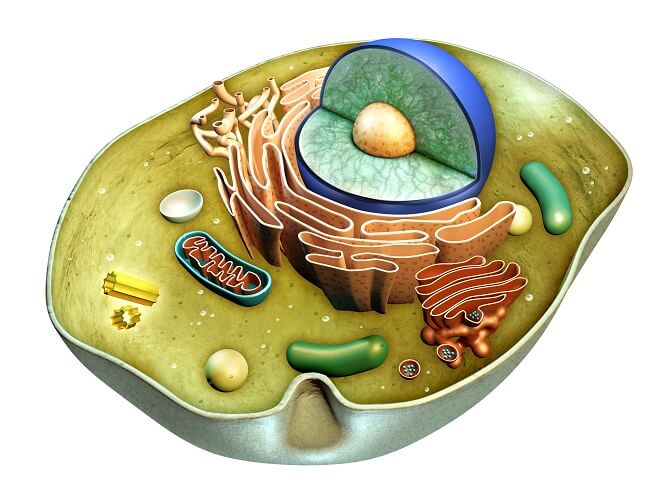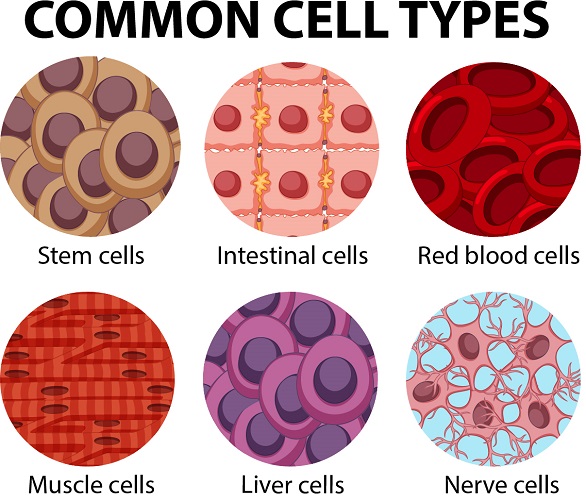Definition
Animal cells are the basic unit of life in organisms of the kingdom Animalia. They are eukaryotic cells, meaning that they have a true nucleus and specialized structures called organelles that carry out different functions. Animal cells do not have plant-specific organelles like cell walls, which support the plant cell, or chloroplasts, the organelle that carries out photosynthesis.

Overview of Animal Cells
Animals, plants, fungi, and protists are all made up of at least one eukaryotic cell. In contrast, bacteria and archaea are made up of a single prokaryotic cell.
All cells are surrounded by a cell membrane (also called a plasma membrane). The cell membrane is the boundary that separates the inside of the cell from the outside of the cell. The plasma membrane encloses all the cell components, which are suspended in a gel-like fluid called the cytoplasm. The cytoplasm is the location of the organelles.
Eukaryotic cells are distinguished from prokaryotic cells by the presence of a defined nucleus and other membrane-bound organelles, such as the mitochondria, endoplasmic reticulum, and Golgi apparatus. Prokaryotic cells do not have a defined nucleus (instead, a region of the cytoplasm – called the nucleotide – holds the genetic material). They also lack membrane-bound organelles.
Animals are all multicellular, meaning multiple cells work together to form the whole organism. In complex organisms, such as humans, these cells can be highly specialized to perform different functions. As such, they often look and function very differently from one another, even though they are all human cells.

Animal Cells vs. Plant Cells
Animal cells and plant cells are both eukaryotic. Thus, they both have a defined nucleus and other membrane-bound organelles. However, animal and plant cells also have some fundamental differences.
Animal cells, unlike plant and fungi cells, do not have a cell wall. Instead, multicellular animals have other structures that provide support to their tissues and organs, such as skeleton and cartilage. Additionally, animal cells also lack chloroplasts found in plant cells. Chloroplasts are specialized organelles that trap energy from the sun and use it as fuel to produce sugars in a process called photosynthesis.
Additionally, while plant cells tend to have a large, central vacuole, animal cells lack this feature. Some animal cells do have small vacuoles, but their function is to assist in the storage and transport of large molecules.
Animal Cell Structure
Animal cells have a variety of different organelles that work together to allow the cell to perform its functions. Each cell can be thought of as a large factory with many departments, like manufacturing, packaging, shipping, and accounting. Different organelles represent each of these departments.
There are lots of different animal cells that each carry out specialized functions. Therefore, not every animal cell has all types of organelles, but in general, animal cells do contain most (if not all) of the following organelles. Additionally, some organelles will be highly abundant in certain cells and not others.

Nucleus
The nucleus contains all the genetic material in a cell. This genetic information is called deoxyribonucleic acid (DNA). DNA contains all the instructions for making proteins, which control all of the body’s activities. Therefore, the nucleus is like the manager’s office of the cell.
DNA is an extremely precious and tightly regulated molecule. Therefore, it does not just exist naked in the nucleus! Instead, DNA is tightly wound around structural proteins called histones to form chromatin. When the cell is ready to divide to pass the genetic information on to new cells (the daughter cells), the chromatin forms highly condensed structures called chromosomes.
The nucleus regulates which genes are turned ‘on’ in the cell, and at what time. This controls the cell’s activity. The genes that are active at a given time will be different depending on the type of cell and the function it performs.
The nucleus is surrounded by a nuclear envelope (also called the nuclear membrane), which separates it from the rest of the cell. The nuclear envelope also contains pores that permit the entry and exit of some molecules.
As well as all the genetic material, there is also a sub-section of the nucleus called the nucleolus, which looks like a nucleus within the nucleus. The nucleolus is the site of ribosome synthesis. The nucleus is surrounded by a nuclear envelope (also called nuclear membrane), which separates it from the rest of the cell.
The nucleus also regulates the growth and division of the cell. When the cell is preparing to divide during mitosis, the chromosomes in the nucleus duplicate and separate, and two daughter cells form. Organelles called centrosomes help to organize the DNA during cell division.

Ribosomes
Ribosomes are organelles found in both prokaryotic and eukaryotic cells. They are like mini machines that synthesize all the proteins in the cell. In any single animal cell, there can be as many as 10 million ribosomes! The ribosomes form the manufacturing department of the cell.
In the nucleus, a sequence of DNA that codes for a specific protein is copied onto an intermediate molecule called messenger RNA (mRNA). The mRNA molecule carries this information to the ribosome, and its sequence determines the order of amino acids in a polypeptide chain. The ribosome synthesizes this polypeptide chain, which eventually folds to become a protein. In animal cells, ribosomes can be found freely in a cell’s cytoplasm or attached to the endoplasmic reticulum.
Endoplasmic Reticulum
The endoplasmic reticulum (ER) is a network of flattened, membrane-bound sacs that are involved in the production, processing, and transport of proteins that have been synthesized by ribosomes. The endoplasmic reticulum is like the assembly line of the cell, where the products produced by the ribosomes are processed and assembled.
There are two kinds of endoplasmic reticulum: smooth and rough. The rough ER has ribosomes attached to the surface of the sacs. Smooth ER does not have ribosomes attached and has functions in storage, synthesizing lipids, removing toxic substances.
Golgi Apparatus
The Golgi apparatus, also called the Golgi complex or Golgi body, receives proteins from the ER and folds, sorts, and packages these proteins into vesicles. The Golgi apparatus is like the shipping department of the cell, as it packages proteins up for delivery to their destinations.
Like the ER, the Golgi apparatus also consists of a series of membrane-bound sacs. These sacs originate from vesicles that have budded off from the ER. Unlike the system of membranes in the ER, which are interconnected, the pouches of the Golgi apparatus are discontinuous.

Lysosomes
Lysosomes are a type of vesicle. Vesicles are spheres surrounded by a membrane that excludes their contents from the rest of the cytoplasm. Vesicles are used extensively within the cell for metabolism and transport of large molecules that cannot cross membrane unaided.
Lysosomes are specialized vesicles that contain digestive enzymes. These enzymes can break down large molecules like organelles, carbohydrates, lipids, and proteins into smaller units so that the cell can reuse them. Therefore, they are like the waste disposal/recycling department of the cell.
Mitochondria
Mitochondria are the energy-producing organelles, commonly known as “the powerhouse of the cell.” The process of cellular respiration occurs in the mitochondria. During this process, sugars and fats are broken down through a series of chemical reactions, releasing energy in the form of adenosine triphosphate (ATP).
ATP is like the energy currency of the cell. Think of each molecule like a rechargeable battery that can be used to power various cellular processes.
Cytoplasm
The cytosol is the gel-like liquid contained within cells. The cytosol and all the organelles within it – except for the nucleus – are collectively referred to as the cell’s cytoplasm. This cytosol consists primarily of water, but also contains ions, proteins, and small molecules. The pH is generally neutral, around 7.
Cytoskeleton
The cytoskeleton is a network of filaments and tubules found throughout the cytoplasm of the cell. It has many functions: it gives the cell shape, provides strength, stabilizes tissues, anchors organelles within the cell, and has a role in cell signaling. It also provides mechanical support to allow cells to move and divide. There are three types of cytoskeletal filaments: microfilaments, microtubules, and intermediate filaments.
Cell Membrane
The cell membrane surrounds the entire cell and separates its components from the outer environment. The cell membrane is a double layer made up of phospholipids (called the phospholipid bilayer). Phospholipids are molecules with a phosphate group head attached to glycerol and two fatty acid tails. They spontaneously form double membranes in water due to the hydrophilic properties of the head and hydrophobic properties of the tails.
The cell membrane is selectively permeable, meaning it only allows certain molecules to enter and exit. Oxygen and carbon dioxide pass through easily, while larger or charged molecules must go through special channels, bind to receptors, or be engulfed.
Quiz
